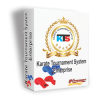Selecting the right AOM driver is crucial for ensuring the optimal performance of your acousto-optic modulator (AOM). Here are some key specifications to consider:
Compatibility
RF Frequency Range: This is the most critical factor. The driver's output frequency range needs to match the operating frequency of your specific AOM. AOMs operate at specific frequencies (e.g., 40 MHz), and the driver must provide a matching RF signal to achieve proper modulation. Mismatched frequencies will result in poor or no modulation.
Output Power
Modulation Depth: The driver's output power determines the intensity of the sound wave generated within the AOM. This sound wave intensity directly affects the modulation depth of the light beam passing through the AOM. Higher power drivers can achieve deeper modulation, where a larger portion of the light beam is affected. However, they also consume more power.
AOM Requirements: Consider the specific requirements of your AOM. Some AOMs might function well with lower power drivers, while others might necessitate a higher power output for deeper modulation and optimal performance.
Modulation Capabilities
Basic vs. Advanced Drivers: Basic drivers may offer simple on/off (gating) functionality for the RF signal. This is sufficient for applications requiring a simple shutoff of the light beam.
Advanced Features: More advanced drivers provide additional functionalities like:
Analog Modulation: This allows controlling light intensity by varying the amplitude of the RF signal based on an analog input signal. This is useful for applications requiring variable light intensity control.
Digital Modulation: Enables rapid switching of the RF signal on and off based on a digital control signal. This is suitable for applications requiring pulsed light or digital signal processing with the AOM.
Additional Considerations
Input Signal Type: Match the driver's input signal requirements (voltage level, digital logic) to your control system. Ensure compatibility between the driver's input and the signal coming from your control electronics.
Pulse Modulation Capabilities: If your application involves pulsed light generation, ensure the driver offers features for pulse modulation, allowing control over pulse width and repetition rate.
Adjustable Gain Control: Some drivers provide adjustable gain control, allowing you to fine-tune the RF signal amplitude sent to the AOM for precise modulation depth control.
Built-in Monitoring Functions: Monitoring features like output power or temperature monitoring can be helpful for troubleshooting and ensuring the AOM and driver operate within safe parameters.
For more information,please click:https://www.cq-smart.com/acousto-optic-modulator-driver
Sign Up
Your Martial Arts Social Media helps you connect and share with the people in your life.





















